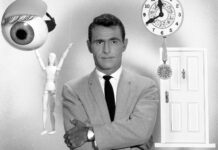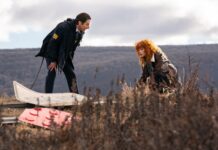[ad_1]
Even though it’ll always be a science fiction show through and through, Battlestar Galactica crossed over into the entertainment mainstream in a way few sci-fi shows ever do. Airing for four stellar seasons from 2004 onward on the Sci-Fi Channel (the precursor to today’s SYFY), BSG transcended the geeky trappings that keep so many space series locked tightly within their genre fandoms, earning awards and accolades typically reserved for dramas with far broader pop culture appeal.
With a killer cast featuring Edward James Olmos, Katee Sackhoff, Mary McDonnell, Tricia Helfer, and more, BSG fused compelling writing with a human-focused, character-driven story — assets that each worked together to lift the series above conventional science fiction fare. But thanks to a separate big emphasis on stripping its sci-fi elements down to their essential, bare-bones basics, series developer Ronald D. Moore also brought an accessibility to Battlestar Galactica that helped the show capture an audience extending well beyond its conventionally limited genre.
Avoiding “technobabble” — The Star Trek lessons Ronald D. Moore brought to Battlestar Galactica
Moore reimagined BSG for a 2000s small-screen viewership already familiar with TV’s earlier science fiction classics — including the original 1978 Battlestar Galactica as well as the original Star Trek and its later spinoffs (like Star Trek: The Next Generation, which Moore himself wrote for and eventually helped produce).
Speaking in 2018 with Wired for a look back at his time on BSG, Moore confided that one of his biggest priorities was to bypass the nerdy sci-fi “technobabble” that characterized shows like Star Trek: The Next Generation, setting it aside in favor of a sleeker, more efficient style of science fiction visual shorthand that ditched lengthy dumps of technical exposition in exchange for gracefully moving forward with each episode’s more absorbing larger story.
“My experience in Star Trek taught me that technobabble could just swamp the drama in a show,” Moore explained. “Especially in a space opera, where you’re on ships in space and dealing with technical things, technobabble becomes a crutch to get into and out of situations. It just leaches all the drama away. The audience doesn’t know what the hell you’re talking about, and you’re making it up anyway. You make up a problem with the Enterprise warp drive, and then you solve it with a made-up problem, too… I just did not want Galactica to be about that. I really wanted it to be about the characters and the story.”
Even today, few big-budget space series can boast the kind of acting talent that BSG enjoyed through its four-season run on cable television. Moore knew the show’s writing team would be spurning a huge opportunity to tap into the cast’s dramatic gifts if they allowed the series to get bogged down in frequent nerd-speak, so they trusted viewers to simply connect the geeky dots whenever BSG encountered especially tech-y scenarios that could occur only within the show’s expansive science fiction lore-verse.
“At the beginning I had fairly complicated routines about how you launch Vipers, and all the little steps you went through,” he offered as an example of how BSG’s writing approach sought to skip past the series’ stickiest technical assumptions. “In the miniseries [which preceded the full Battlestar Galactica series as a soft pilot lead-in in 2003], I was at pains to show that, OK, this is how we launch Vipers, there’s all these steps and preps and tech. But you get into the series, and it’s like, we don’t have time for any of that. Just launch the Vipers.”
Longtime fans know that Battlestar Galactica kept its space story focused squarely on people, eschewing sci-fi tropes like aliens (which star actor Olmos famously flagged as a no-go) while placing a dramatic premium on how the universe’s last remaining humans would shepherd their own survival.
“I had a list of ‘don’ts’ at the very outset” of the series, he said. “We weren’t going to do time travel. We weren’t going to do evil twin stories. We weren’t going to encounter aliens that control our minds. There were all these tropes of sci-fi that we just were not going to do.”
In the end, BSG evolved into a small-screen classic for both science fiction fans as well as everyday TV viewers, thanks in part to its insistence on keeping its characters — and not its far-flung space lore — front and center. “It was always going to be about these people, the moral choices that they make, their mistakes, their loves, their hates,” Moore reflected. “I was more interested in a story about the characters than the sci-fi of it.”
Ready for more character-driven sci-fi? Stream the first two seasons of SYFY’s The Ark on Peacock here… while we wait for more news on the show’s recently-announced third season!
[ad_2]
Source link








